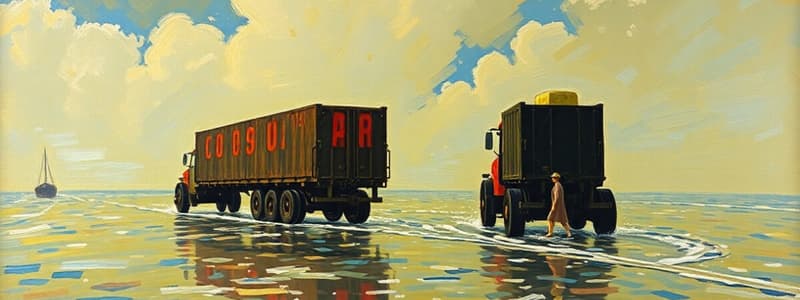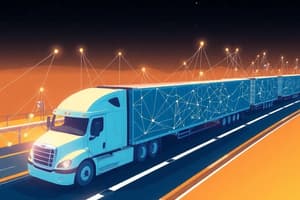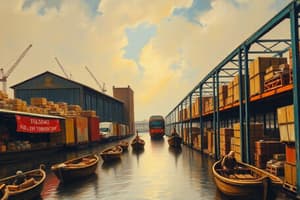Podcast
Questions and Answers
What is the estimated size of the logistics sector in India?
What is the estimated size of the logistics sector in India?
- $150 billion
- $215 billion (correct)
- $300 billion
- $100 billion
What percentage of GDP is the logistics cost in India estimated to be?
What percentage of GDP is the logistics cost in India estimated to be?
- 12%
- 8%
- 14% (correct)
- 10%
What is the current CAGR of the logistics sector in India?
What is the current CAGR of the logistics sector in India?
- 5.5%
- 15%
- 12%
- 10.5% (correct)
How many people does the logistics sector employ in India?
How many people does the logistics sector employ in India?
What is the aspirational logistics cost percentage for developed countries?
What is the aspirational logistics cost percentage for developed countries?
What is the correct term for the structured series of ports and connections in supply chain networks?
What is the correct term for the structured series of ports and connections in supply chain networks?
Which of the following is NOT included in the multi-modal supply chain?
Which of the following is NOT included in the multi-modal supply chain?
What is likely emphasized in a supply chain with a focus on serviceability?
What is likely emphasized in a supply chain with a focus on serviceability?
In supply chain models, what does CRM stand for?
In supply chain models, what does CRM stand for?
What does the term 'direct supply' imply in a supply chain context?
What does the term 'direct supply' imply in a supply chain context?
What is a potential benefit of using a multi-nodal supply chain?
What is a potential benefit of using a multi-nodal supply chain?
Which number best represents the total supply chain connections shown in the diagram?
Which number best represents the total supply chain connections shown in the diagram?
Which part of the supply chain is concerned with overseeing the flow of goods and services?
Which part of the supply chain is concerned with overseeing the flow of goods and services?
Flashcards
India's logistics sector size
India's logistics sector size
Estimated at $215 billion and growing at 10.5% CAGR.
Indian logistics employment
Indian logistics employment
Employs 22 million people.
India's logistics cost
India's logistics cost
Estimated at 14% of GDP (Gross Domestic Product).
Developed vs. Developing Logistics Cost
Developed vs. Developing Logistics Cost
Signup and view all the flashcards
Comparison of Logistics Modes
Comparison of Logistics Modes
Signup and view all the flashcards
Supply Chain Network
Supply Chain Network
Signup and view all the flashcards
Logistics FG Material Movements
Logistics FG Material Movements
Signup and view all the flashcards
TSM Works
TSM Works
Signup and view all the flashcards
Supply Chain Networks
Supply Chain Networks
Signup and view all the flashcards
Direct Supply
Direct Supply
Signup and view all the flashcards
Multi-Model Supply
Multi-Model Supply
Signup and view all the flashcards
Serviceability
Serviceability
Signup and view all the flashcards
Port
Port
Signup and view all the flashcards
Study Notes
Logistics Cost Breakdown in India
- India's logistics sector is a significant part of the economy, valued at approximately $215 billion, with a growth rate of 10.5% per year.
- The sector employs 22 million people, according to the Ministry of Commerce and Industry.
- Logistics costs in India are estimated to be 14% of the country's GDP.
- In developed countries, the logistics cost is typically 6-7% of GDP.
Supply Chain Structure
- The supply chain includes raw material supply, manufacturers, distributors, wholesalers, retailers, and end-users.
Comparison of Transportation Modes
-
Truck: Cost-effective for short distances, quick delivery for short to medium distances, limited by size and weight restrictions, extensive market reach, reliable (but prone to traffic delays), lower fuel efficiency & higher impact on environment.
-
Rail: One of the most cost-effective modes for large volumes and long distances, comparable speed to trucks, high capacity, reaches major markets, reliable, and environmentally friendly.
-
Water: One of the least expensive modes, slow transit time, limited by navigable waterways, less visibility, reliable (but subject to weather and infrastructure delays), environmentally friendly.
-
Air: Fastest mode for long distances, high carrying capacity (but with low capacity compared to other modes), expensive, easily impacted by weather, and a high environmental impact.
Logistics Terms and Definitions (Velotrade)
- A standardized way of defining responsibilities and who pays for what in a supply relationship.
- EXW (Ex Works): Seller's obligation ends at the seller's premises.
- FCA (Free Carrier): Seller delivers goods to the carrier designated by the buyer at a named place.
- FAS (Free Alongside Ship): Seller delivers goods alongside the ship at a named port.
- FOB (Free On Board): Seller delivers goods on board the ship at a named port.
- CFR (Cost and Freight): Seller delivers goods to the destination port.
- CIF (Cost, Insurance, and Freight): Seller delivers goods to the destination port with insurance.
- CPT (Carriage Paid To): Seller pays for transportation to the agreed-upon destination.
- CIP (Carriage and Insurance Paid To): Seller pays for transportation and insurance to the agreed-upon destination.
- DPU (Delivered at Place Unloaded): Seller delivers goods to a named location.
- DAP (Delivered at Place): Seller delivers goods to a named place.
- DDP (Delivered Duty Paid): Seller delivers goods to a named destination, including all duties and taxes.
Supply Chain Network Diagram
- Illustrates the flow of goods and costs through the various stages of the supply chain, from suppliers to customers.
- Shows the components and costs associated with the different stages of the supply chain (transportation, manufacturing, inventory).
Types of Supply Chain Networks
- Cross-Docking: Faster delivery of products.
- Milk Run: Delivery to groups of customers in a single or scheduled route.
- Hub and Spoke : Central hub with access points (spokes).
Geographical Spread of Logistics Network
- The network is strategically located near mines and ports for easy access and optimized delivery times.
- Focus on a customer-centric approach, placing warehouses and processing centers close to customers to reduce transit time.
Logistics Material Movement and Flows
- A detailed visual representation of how materials flow through the logistics process. This showcases a possible physical flow through the supply chain.
Strategic Supply Chain Network Design Framework
-
Components for developing frameworks for supply chain:
- Operational: Supply Chain Framework, Structure, & Operating policy, real-time information.
- Tactical : Defined framework, Time-based facility/product process framework, & business plans.
- Strategic : Corporate strategy, investment plans, and business plans.
Types of Supply Chains
- Lean supply chain: Eliminates waste and processes without value for the end consumer.
- Agile supply chain: Improves responsiveness and flexibility to changing market conditions.
- Green supply chain: Reduces the environmental impact of activities in the supply chain.
- Closed-loop supply chain: Includes forward and reverse supply, encompassing collection, recycling, and resource recovery.
- Sustainable supply chain: Combines social responsibility with environmental considerations to enhance value for customers and stakeholders.
- Risk supply chain: Addresses uncertainties, such as natural disasters or economic crises.
Customer Need & Supply Characteristics Matrix
- This matrix shows how to manage supply chain needs across different customer qualities.
Logistics Service Levels
- Different levels of involvement from one party to the next in the supply chain.
Company Financial Outlook/Market Size Projection
- Information on the company's projected financial performance, as reported from market research data.
Studying That Suits You
Use AI to generate personalized quizzes and flashcards to suit your learning preferences.




